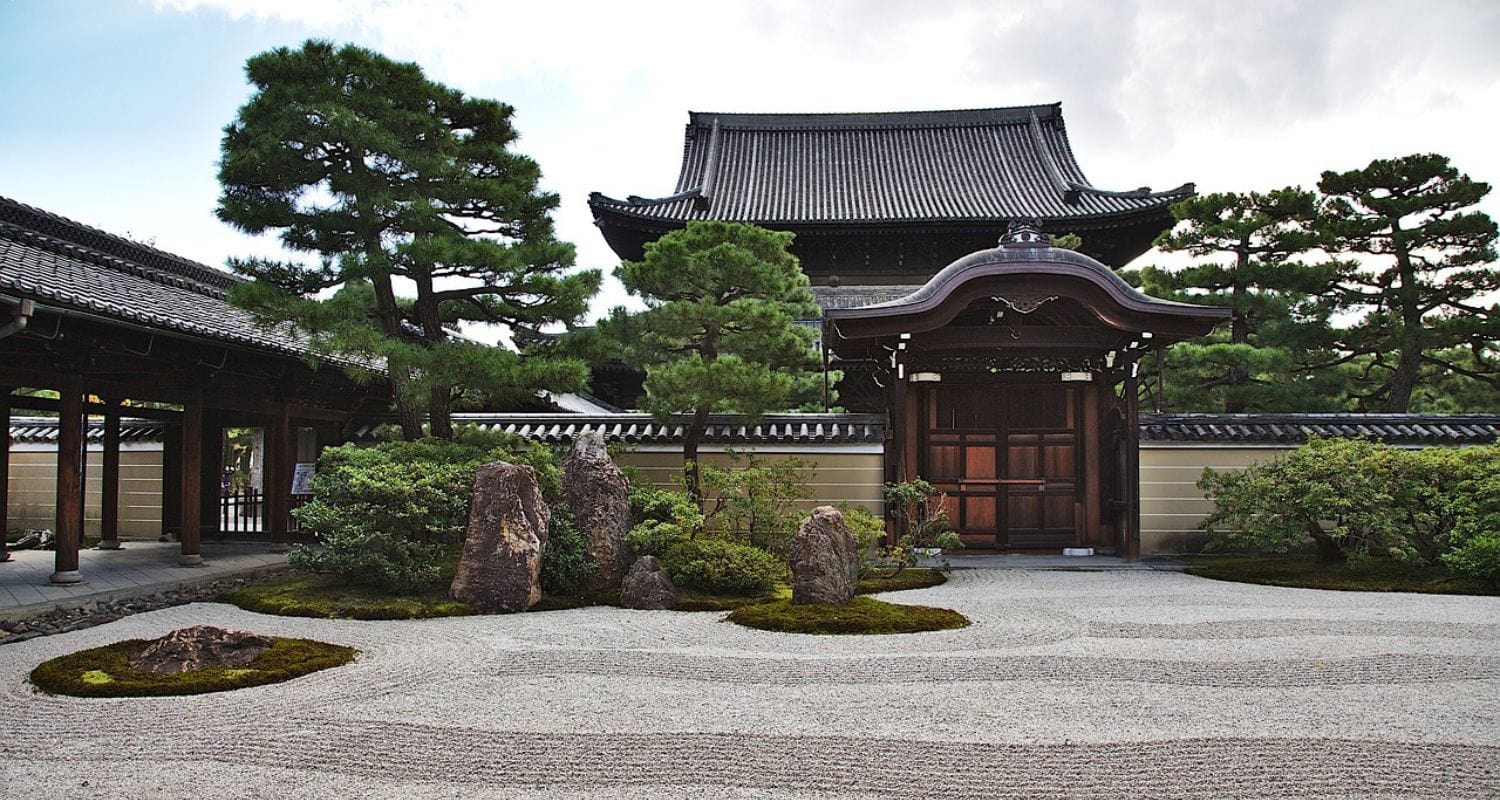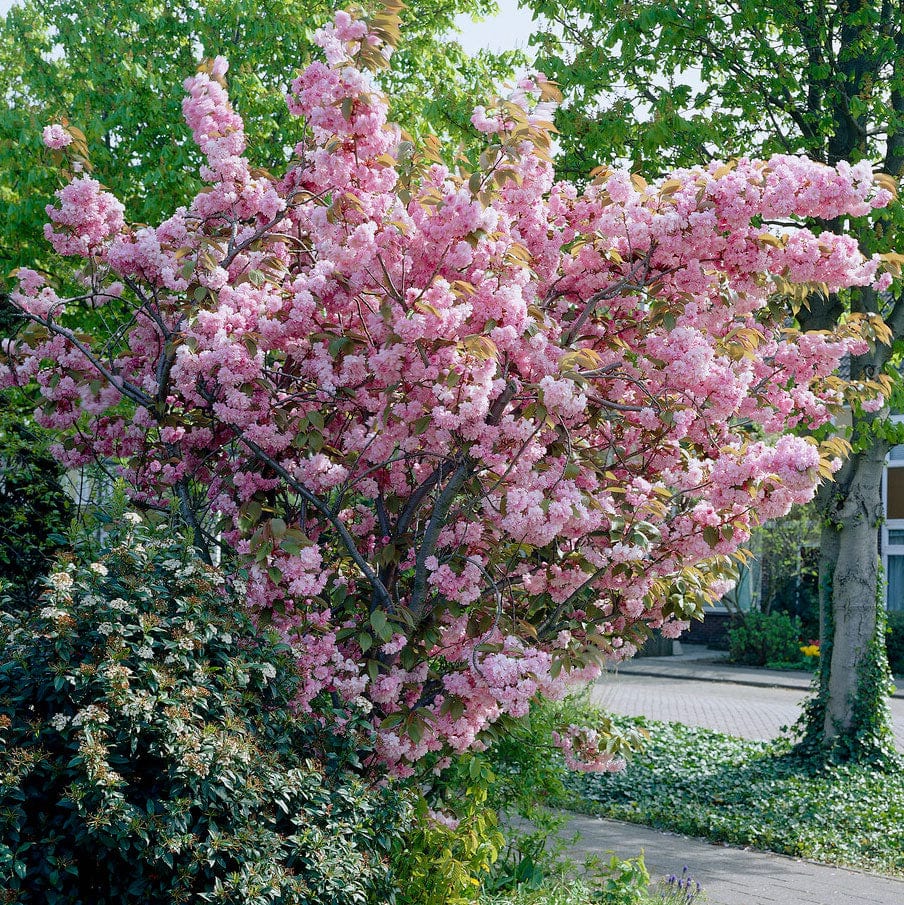Advice & Inspiration
Japanese Garden Ideas

Few countries have imparted such a distinctive and long-lasting influence on horticulture as Japan. Their elegant, peaceful spaces utilise a range of overarching principles and practices that look as good today as they would have many centuries ago. Whether you have a large, sprawling garden that you want to add a Japanese-style section to, or are looking to convert what little outdoor space you have in its entirety, we’ve got you covered.
Jump to:
- Design principles of Japanese gardening
- Types of Japanese gardens
- Plants used in Japanese gardens
- Notable Japanese gardens in the UK
What makes a Japanese-style garden?
There’s no one thing that makes a Japanese garden, but rather a collection of underpinning concepts that work in tandem to create spaces that evoke both a sense of contemplative calm and an appreciation of the natural world.
Exploring key principles behind Japanese garden design
There are several primary ideas one might deem integral to the success (or lack thereof) of any true Japanese-style garden. Of course, the following is by no means an exhaustive list and rather should be treated as a sort of starting point for your space, from which you can explore additional ideas and styles. Some of the most important principles include:
Asymmetry (fukinsei)
A key difference between Japanese gardens and many styles of garden developed in Western countries (namely the English knot garden and the French formal garden) is the celebration and promotion of asymmetry (or fukinsei).
Japanese gardens look to embrace non-uniformity, reflecting the idea that life and nature are imperfect. This principle applied in practice might look like implementing winding, rather than straight paths, and arranging rocks in uneven, irregular ways.

Borrowed scenery (shakkei)
A concept first referenced (as jièjǐng) in a seminal Chinese gardening guide, Yuanye, in 1631, similar principles to ‘borrowed scenery’ were mentioned as far back as the 11th century in Japan. Shakkei involves incorporating a landscape outside of the garden (the view of a mountain in the distance, for example) into the garden to become part of its design.
So, if you live near to an impressive mountain, piece of architecture or a lake, then you can try to frame your garden in such a way that those features supplement your garden; an important aspect of this principle is that your foreground (i.e. your own garden) is in continuity or harmony with the background.
Gardens with a lakeside view, for example, might implement a series of ponds or streams, while outdoor spaces backing onto a hillside might make use of constructed tsukiyamas (hills/mounds) in the foreground.

Naturalness (shizen)
Another important element within Japanese garden design is the idea of shizen, or naturalness. Pruning a tree in such a way that it goes with its natural bend, for example, rather than trying to force it into the shape you want, would be an example of shizen in practice. You’re looking to work with nature, as opposed to trying to exert dominance over it.

Simplicity (kanso)
A core tenet of most Japanese gardens is the idea that less is often more. You’ll rarely find ‘busy’ or cluttered Japanese-style garden spaces, and a successful garden will leave you feeling that every inclusion has been painstakingly thought out.

Quietness or tranquility (seijaku)
When people think of Japanese gardens, one of the things they first tend to think of is the sense of peace and tranquility imbued within them. The use of water features (like a suikinkutsu, or water harp) and wind chimes (known as fūrin) are both easy ways you can begin to bolster your garden’s overall feeling of still, meditative calm.

The main types of Japanese garden
Another way you can think about Japanese-style gardens is by categorising them per their function or purpose. Below, we’ve listed some of the primary styles of Japanese gardens:
Dry rock garden (karesansui)
Often also referred to as Zen gardens, after Zen Buddhism, karesansui gardens utilise a combination of raked gravel, sand, carefully placed stones and sometimes moss, shrubs or trees in order to create a peaceful place for contemplation and reflection. Circular patterns are often raked into the gravel, as this shape (ensō) symbolises absolute enlightenment.

Hill garden (tsukiyama)
Sometimes also known as a hill-and-pond garden, a tsukiyama garden (which is also the term used to describe the hills, themselves) comprises a mixture of man-made hills and ponds, resulting in a garden with greater depth and interest, and which better reflects the natural Japanese landscape (almost three-quarters of Japan is taken up by mountainous terrain).

Tea garden (roji or cha-niwa)
There are few countries for whom tea holds such cultural significance as does Japan. And while we might like our milky builder’s brews over here in the UK, the tradition and decorum surrounding Japan’s cherished green tea ceremonies (chanoyu) is something truly wonderful to behold.
Tea gardens (also known as roji or cha-niwa) feature a pathway of paving stones, known as tobi-ishi, which may be lined with lanterns (tōrō). There will also be a purification basin called a tsukubai and the tea house, itself – the chashitsu. Moss often features in these gardens, alongside bamboo and trees like maples, Japanese black pines, magnolias and camellias.

Compact urban garden (tsubo-niwa)
Japan is also known for its densely-packed metropoles, and many people don’t have access to anything other than a very small outdoor space attached to their property. Tsubo-niwa are courtyard-style gardens that introduce natural light into the home, are economical, and require little in the way of maintenance.
Stroll garden (kaiyū-shiki-teien)
Stroll gardens are pretty self-explanatory; they’re gardens through which you’re meant to stroll! Pathways are therefore an important component of this particular garden type. You’re looking to create a pleasant walking experience for your garden, so paths circulating a central pond or weaving through interlocking hillocks are both good choices.

Pond garden (ikeniwa)
Water plays an important role in many Japanese gardens, so it’s no surprise that gardens with ponds (ikeniwa) have made this list. Japanese pond gardens often feature koi carp, which enjoy an enduring place in national culture, while planting might include Japanese water iris (Iris ensata), Japanese sweet flag (Acorus gramineus) and barred horsetail (Equisetum japonicum).

What plants are commonly used in Japanese gardens?
So, now that you hopefully have an understanding of just what makes a garden Japanese, stylistically speaking, it’s time to talk about plants…
Acer palmatum (Japanese maple)
Japanese maples (irohamomiji) are bloomin’ brilliant trees, they really are. Whether you only have room for something compact like ‘Garnet’ or are able to plant something a bit bigger, such as ‘Red Emperor’, these evocative plants provide excellent colour (particularly in the autumn) and a nice contrast to plants with green foliage. Acers are low-maintenance plants, but it’s worth checking out our guides (both planting and pruning) to ensure your tree stays happy and healthy.

Bambusa and Phyllostachys (clumping and running bamboo)
Bamboo (take) is ubiquitous in Japan and a mainstay in many Japanese gardens. There are two types of bamboo, clumping and running, and both are used in Japanese-style gardens. Bamboo offers an effective way to add privacy to a garden, creates texture and depth, and grows nice and quickly. It also symbolises vitality and prosperity in Japanese culture. Here at Roots, we’re particularly fond of the visually-striking black bamboo and the elegant golden bamboo (also known as fish-pole bamboo).

Prunus (cherry)
Cherry trees (particularly blossom varieties) hold arguably unparalleled significance within Japanese culture; the cherry blossom (sakura) is the country’s national flower and has been the basis for the traditional custom of hanami (flower viewing) since the Heian period (794-1185AD).
There are a huge number of different cherry blossoms out there, from the showstopping ‘Kanzan’ to the diminutive ‘Kiku-shidare-zakura’, and from the proud, slender ‘Amanogawa’ to the giant blossoms of ‘Tai haku’, there’s a cherry blossom tree to suit all wants and needs. Make sure to check out our cherry blossom planting and pruning guides to get the most from your tree.

Paeonia (peony)
Peonies (botan) are another plant commonly seen in Japanese gardens, their tasteful blooms coming in a range of hues and sizes. There’s even a garden in Tokyo dedicated solely to peonies (located in the grounds of the Ueno Toshogu shrine).
Japanese gardens don’t typically feature huge amounts of bright, bold colour, but rather a carefully picked selection of plants (including peonies) used in a highly intentional manner. We’re especially fans of the itoh peonies ‘Bartzella’ and ‘Hillary’, whose flowers are wonderfully stylish flowers without ever being garish.

Camellia japonica (Japanese camellia)
Camellias (tsubaki) are among the most spectacular evergreen shrubs, and have long been popular in Japan (they were thought to have first been brought over from China in the 7th century). Their glossy evergreen leaves serve as the perfect backdrop for the graceful blooms (typically red, pink or white in colour). Check out ‘Triumphans’, whose pastel pink flowers will elevate any space.
The camellia garden at Tokyo Metropolitan Oshima Park features a staggering 5,000 camellias! But if you want to see some brilliant camellias here in the UK, then head on down to Cornwall and take a stroll around the magnificent gardens at Caerhays Estate, which feature a huge number of different camellias, as well as being home to Camellia × williamsii.

Wisteria floribunda (Japanese wisteria)
Last (but certainly not least) on our list is Japanese wisteria (fuji). This cascading climber makes a brilliant addition to any garden, its flowing purple or white racemes improving any pergola, arch or arbour it’s trained over.
Unlike Chinese wisteria, Japanese wisteria grows clockwise, while the latter also typically has more leaflets per leaf than the former. Japanese wisteria also tends to have longer flower racemes.
Knowing how to properly care for your wisteria is important in ensuring it performs as well as it can do, year after year. Luckily for you, we’ve written care, pruning and training guides for wisteria, ready and waiting for you to look at.
Often featured in traditional literature and art, Japanese wisteria remains a highly popular plant in its native country, and are often seen in parks, shrines and temples.

Famous Japanese gardens
Here in the UK, the most famous examples of Japanese gardens include Holland Park’s Kyoto Garden, Hammersmith Park’s Japanese Garden of Peace, Tatton Park’s Japanese Garden, St. Mawgan’s Japanese Garden, Birmingham Botanical Gardens’ Japanese Garden and The Japanese Garden at Cowden, to name just a few.
Final thoughts
It’s no wonder that so many gardeners here in the UK want to emulate the Japanese style in their own gardens. After all, who doesn’t want their own slice of peaceful paradise in their back garden?
Hopefully, having read this, you’ll realise that creating your own Japanese-style garden, or at least implementing some of the main principles, is well within the scope of most budding horticulturalists. For now, though, doumo arigatou gozaimasu!

























